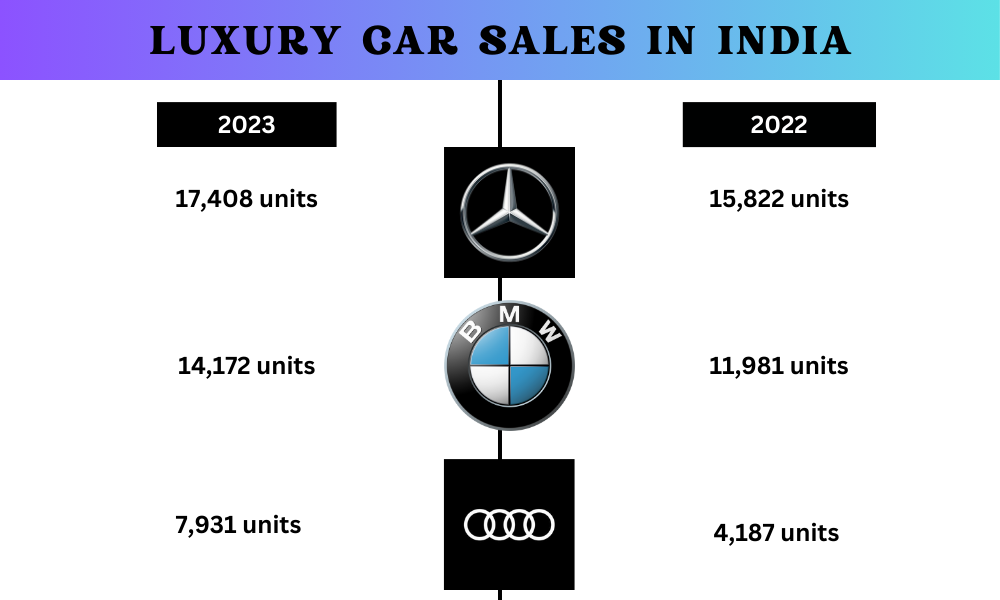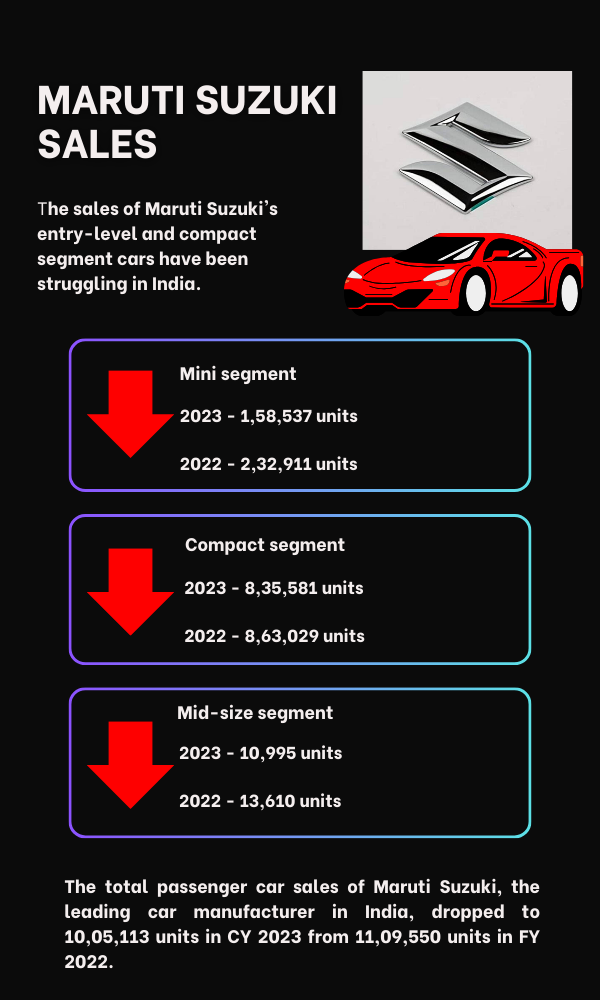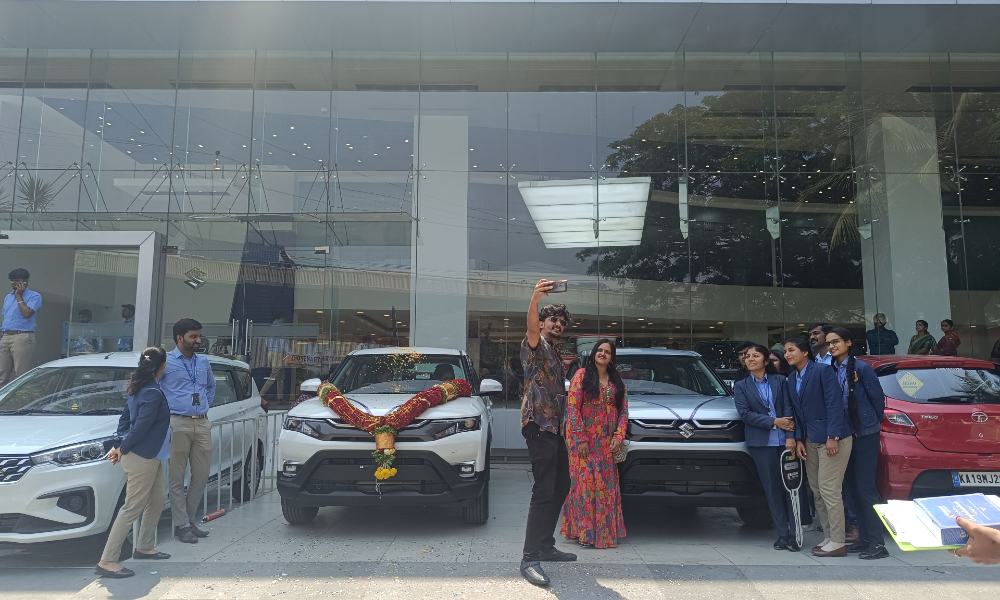Experts say that the increasing purchase power of the public and the availability of options to choose from would propel the automobile industry in the country.
Bharath and Prameela are thrilled about purchasing their first car. Until now, their family of four had to rely on a two-wheeler for transportation. However, as their two little girls are growing up, they wish to provide them comfort and safety, away from the dust and heat. They feel that this is the perfect time to buy a car for their family. Although the car may not be luxurious, it meets their family’s needs perfectly, they say. For people like Bharath and Prameela, buying their first car is a dream come true. And it is these dreams that propel the country’s automobile industry.
The automobile industry in India recorded an 11 percent year-on-year growth in the calendar year 2023, according to data from the Federation of Automobile Dealers Association (FADA). Additionally, the sales of passenger vehicles in the country also grew to 38.60 lakh units from 34.89 lakh units in 2022. However, while the reports point out that the country’s luxury car sales have seen growth, the same cannot be said for entry-level cars.
In 2023, Mercedes-Benz led India’s luxury car market with the sale of 17,408 units, surpassing the 15,822 units sold in 2022. BMW followed closely with annual sales of 14,172 units, compared to the 11,981 units sold in the previous year. Audi also reported a significant growth in sales by selling 7,931 units in 2023 as opposed to 4,187 units in 2022. All these major luxury car players in the country witnessed impressive growth in their sales figures.
However, the sales of Maruti Suzuki’s entry-level and compact segment cars have been struggling in India. The sales of its mini segment cars, Alto and S-Presso, decreased to 1,58,537 units in CY 2023 from 2,32,911 units in FY 2022. Similarly, the sales of its compact segment cars, including Baleno, Swift, Dzire, and WagonR, fell to 8,35,581 units in CY2 2023 from 8,63,029 units in FY 2022. The mid-size segment car Ciaz also experienced a notable decrease in sales, falling to 10,995 units in CY 2023 from 13,610 units in FY 2022. As a result, the total passenger car sales of Maruti Suzuki, the leading car manufacturer in India, dropped to 10,05,113 units in CY 2023 from 11,09,550 units in FY 2022.
Praveen Kumar K., Senior Relationship Manager at Maruti Suzuki’s Mysore Road showroom attributed the increased sales of premium cars in India to the features they offer. “The public has become more aware of the latest car features and do not mind spending a little extra for the safety and comfort the premium cars provide,” he said. SUVs (Sports Utility Vehicles) and EVs (Electric Vehicles) have seen a surge in sales because of their premium safety features, advanced technology, and sleek design, he added. “With the increasing purchasing power of people, they are moving towards vehicles that offer them convenience, comfort, and safety, and away from entry-level cars that have limited safety features,” he said. However, he added that companies are planning to introduce new colours and designs in their entry-level models to retain their customer base.
According to FADA, the primary factors that drive the automobile industry are enhanced buying power, availability of a wide range of models and variants, attractive financial options, and favourable market sentiment.

Krupanandan Raja, a trainer at Toyota’s Mysore Road showroom said that the automobile industry has been boosted by the variety of buying options provided by automobile dealers such as zero down payments and lower EMIs. “The purchasing power of people has also gone up. Earlier, when someone planned to buy their first car, they would usually go for cars in the Rs. 5 lakh range. But now this has changed. With the increase in basic salaries, people feel ready to aspire for cars in the Rs. 15 lakh range,” he said. He attributed the rise in luxury car sales to the improved lifestyle and buying aspirations of the people and their desire to experience luxury. He added that the safety features, advanced technology, and increased fuel efficiency are other factors that influence the buying decisions of the customers.
Arindam Choudhary, a working professional, said that he had been saving money for some time to buy his first car. “I had an estimated budget of Rs. 12 to 13 lakh for the car. After going through a few options and taking a few test drives, I finally chose a compact SUV that had the features that matched my needs,” he said.
Spandan Bora, a Research Analyst at the Centre for Monitoring Indian Economy (CMIE), said that the rise in luxury car sales in India may be linked to the country’s economic growth, but this does not necessarily mean that individuals’ incomes have also increased. “Higher GDP does not always translate to a higher per capita income,” he said.
In India, cars are considered a status symbol, he said. “For Indians, bigger means better. Hence, the bigger the car, the pricier it is, the higher your status in society,” he said. This has led to the popularity of compact SUVs, which now lead the market once dominated by hatchbacks and then sedans. However, he added, that despite the increased car sales in India, the two-wheelers would still be in demand. “The two-wheelers would continue to be in demand for their affordability, ease in navigation, and the poor road conditions of the country,” he said.
Sumit Kapri, who previously worked in the automobile industry, attributed the rise in luxury car sales to the advanced technology and safety features that they offer. “People nowadays have multiple sources of income and can afford to spend more on cars that provide better features and safety technologies,” he said. Those who can afford the top models of entry-level cars are now pushing their limits to purchase the base models of premium cars to be able to experience the luxury, he added.

Soumyasish Bose, an engineer at TATA Motors said that the best-selling luxury car brands in India include Mercedes-Benz, Jaguar-Land Rover, BMW, Audi, Toyota, and Hyundai. “These companies have not only established manufacturing plants in India but have also set up research and development centres to tailor their products for the Indian market,” he said. Initially, foreign brands entered the Indian automobile market through collaborations with existing Indian original equipment manufacturers (OEM), to understand the nuances of the market. However, it soon became clear to them that importing high-priced vehicles did not align well with India’s price-sensitive consumer base, he said. “Nevertheless, the aspirational drive among Indian consumers to own a luxury car despite the high price fueled the luxury car market in the country and prompted these brands to establish manufacturing and assembly plants within the country,” he said.
The present rise in luxury car sales can be attributed to a significant rise in disposable income and an improved standard of living among consumers, he said. “This economic shift has resulted in a visible transition of individuals from the middle class to the upper middle class, and subsequently to the upper class of society,” he said. Even in the lower-end segment of the automobile market, there is a trend where consumers who previously opted for entry-level cars now prefer high-end variants. This shift has been driven by technological advancements that have been seamlessly integrated into these vehicles, further accelerating the growth of the industry, he said. “Moreover, the trend of purchasing second-hand luxury vehicles highlights consumers’ desire to experience luxury before committing to a big purchase,” he added.
Modern-day consumers prioritise features and safety when it comes to choosing a car, he said. “While SUVs, which are meant for off-roading, may not be a necessity in India, people often prefer them as it reflects their social status and aspirations,” he said. Owning a car has become more than just a utility; it has become a symbol of ambition and prestige, he added. “However, for first-time car buyers, purchasing a car is still an emotional journey. They usually prefer low-end cars as they cater to their needs and fit their budget,” he said. This is evident in the sales of Maruti Suzuki, which continues to lead the automobile sector in the country, he added.
The story of cars in India started in the late 1800s when the first car was driven on the Indian roads in 1897. But it wasn’t until 1942 that an Indian-made car, by Hindustan Motors, came out. Things picked up in the 1980s when Maruti Udyog Limited came into the picture, giving tough competition to Hindustan Motors and Premier. The Maruti 800 was a hit among the people because of its affordability and remained a best-seller for the next few years.
After India opened up its economy, big foreign players like Hyundai and Honda entered, and manufacturing boomed across the country. And luxury cars arrived in India with Mercedes-Benz leading the pack in 1994, followed by BMW, Audi, and others, making luxury more accessible in India.
With the Indian automobile sector projected to grow to cater to the aspirations of its consumers, experts said that the industry’s hiring practices are also set to pick up pace. According to a report by Taggd, a digital recruitment platform, the automotive industry would witness a 20 percent surge in hiring intent in 2024, due to the sector’s expectation of increased demand.
Krupanandan said, “The market is evolving and companies are seeing increased sales. This would mean setting higher targets which would require more personnel to achieve it.”



